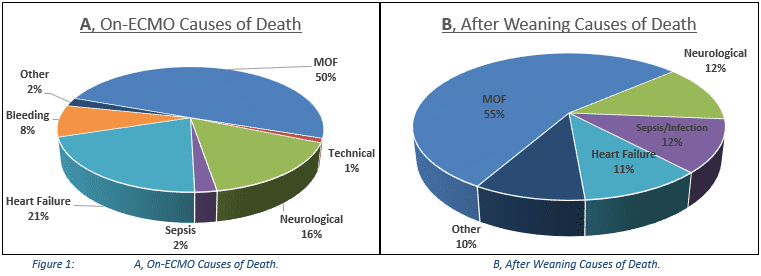
Understanding the ”Extra-corporeal Membrane Oxygenation Gap" in Veno-arterial Configuration: Timing and Causes of Death
2Department of Cardiothoracic Surgery, Maastricht University Medical Center
Objective: The aim of this study was to investigate the causes of in-hospital mortality on-ECMO and after weaning in adult patients undergoing Veno-Arterial ECMO (V-A ECMO).
Study selection: A systematic search was done using PubMed using the terms: Extracorporeal Life Support, ECLS, and Extra-Corporeal Membrane Oxygenation, ECMO. In total, 12,443 articles were identified about ECMO. After excluding Veno-Venous (V-V) ECMO or papers describing combined V-A ECMO series, pediatric series, experiences with less than 10 patients, duplicate papers, and series investigating other assist devices only, 96 published adult V-A ECMO papers with various indications remained. Rates and causes of in-hospital mortality were then divided to on-ECMO and after weaning defined as “ECMO Gap” (in-hospital mortality rate after successful ECMO weaning).
Results: Overall, 12,569 patients were included. On-ECMO mortality was 29%, whereas after weaning was 21.2%. Only 17% of the articles specified the causes of patient death. In these papers, on-ECMO mortality rate was 37% and after weaning 8.7%. Discharge rate in the overall analysis was 30.9% and 50.6% in the group describing the causes of death. Almost half of the weaned patients died in hospital (2670/5988).
The most common causes of death on ECMO were multiple organ failure (MOF) (50%), followed by cardiac failure (20.5%), and neurological complications (16%). The most common cause of death after weaning was MOF (55.3%), followed by neurological complications (12.6%) and heart failure (10.6%). (Fig.1)
Conclusion: Overall, almost one-third of adult V-A ECMO patients die on support. Additionally, half of the patients who are successfully weaned also die in hospital. MOF was the most frequent cause of death after weaning. The differentiation between on-ECMO and after weaning mortality is currently not well-defined in the literature. Further detailed analysis of in-hospital V-A ECMO outcome is therefore necessary to enhance understanding of V-A ECMO success and failure.


Powered by Eventact EMS